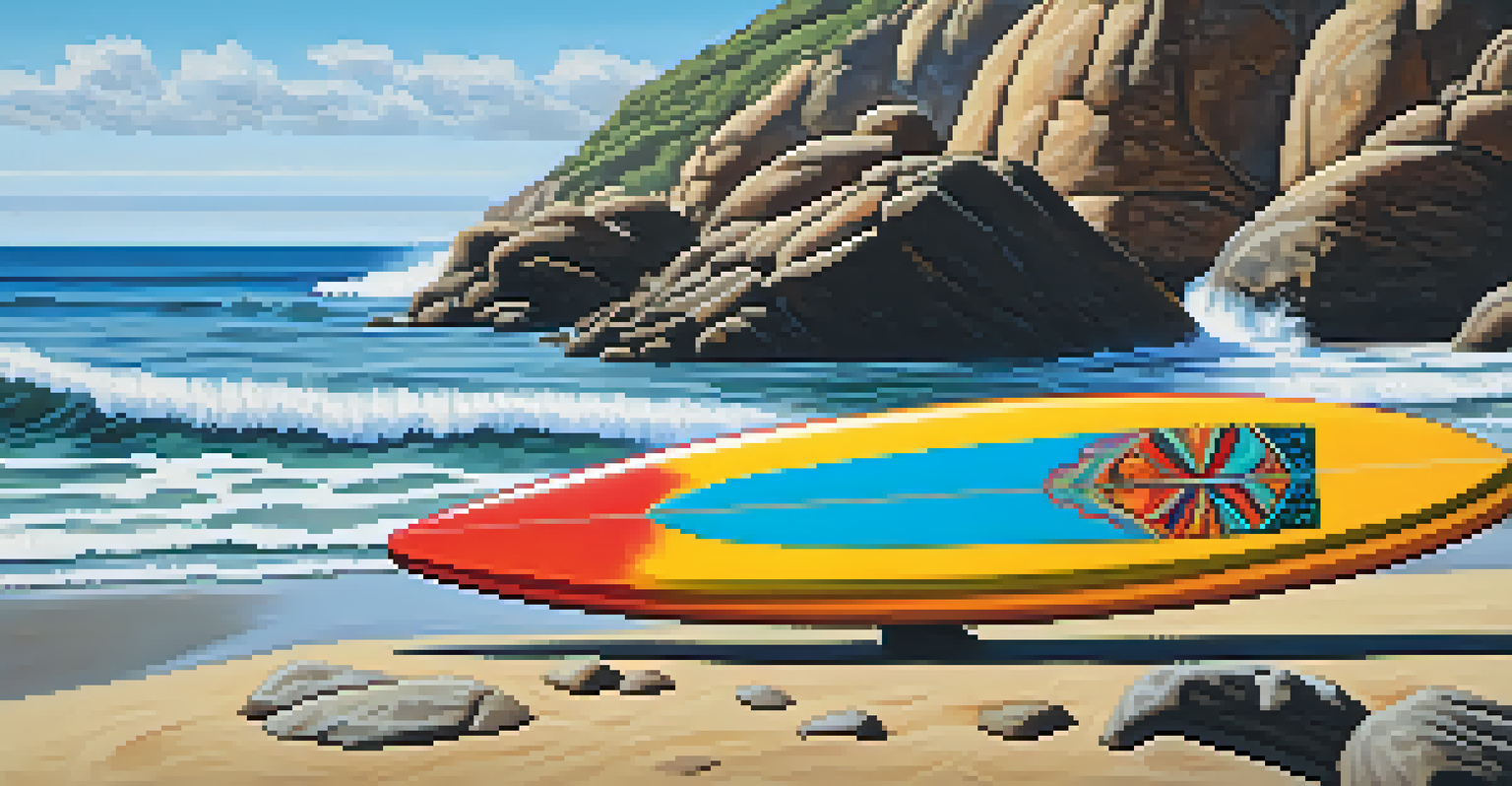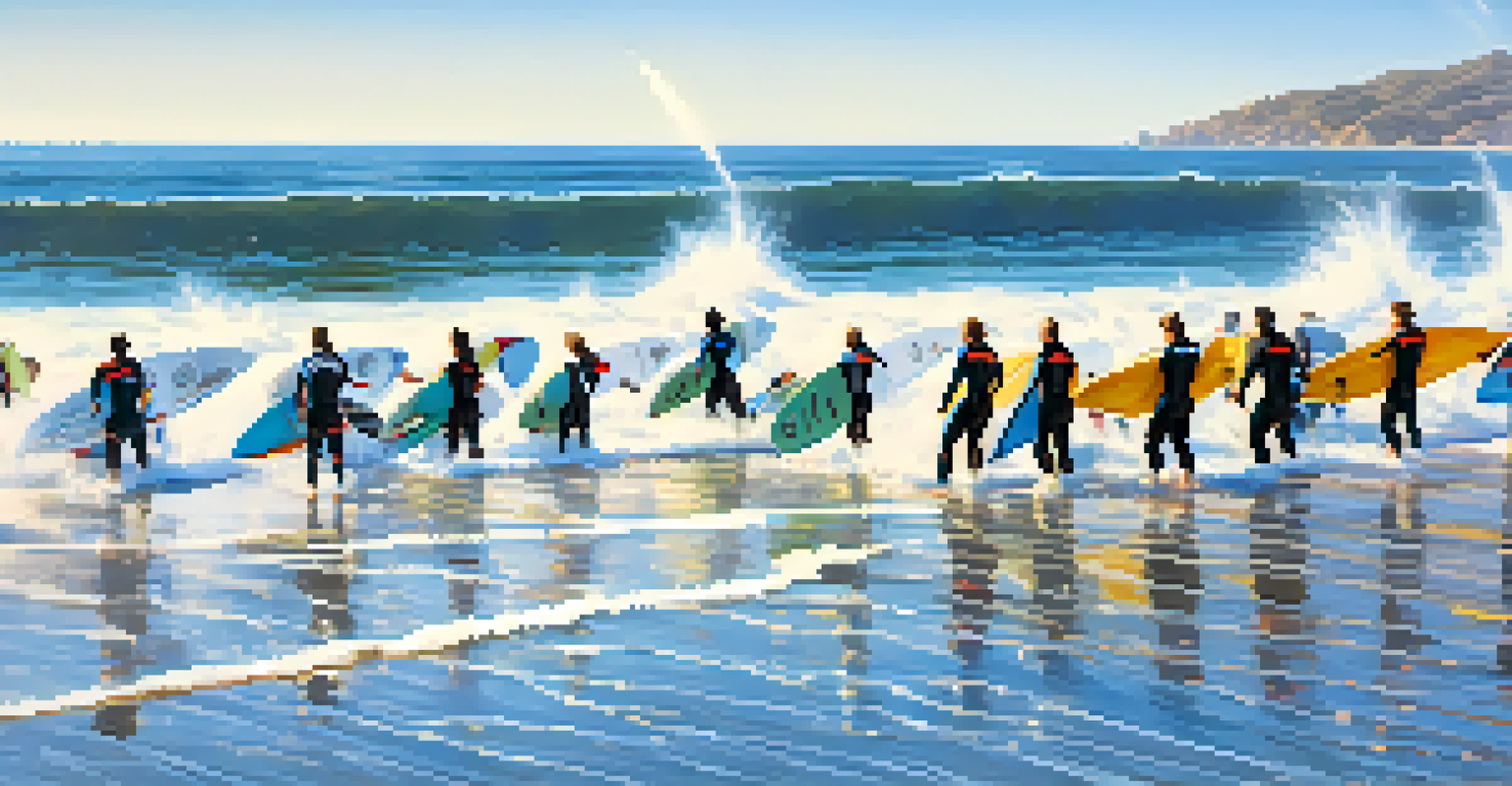The Origins of Surfing: Malibu's Role in Shaping the Sport

The Ancient Roots of Surfing: A Global Perspective
Surfing isn't just a Californian pastime; its roots stretch back thousands of years. The earliest known surfers were the Polynesians, who rode waves on wooden boards made from local trees. This ancient practice was not just a sport but a significant cultural activity that connected communities and served as a rite of passage.
Surfing is the most blissful experience you can have on this planet, a taste of heaven.
As Polynesian voyagers traveled across the Pacific, they brought their surfing traditions with them, influencing coastal communities along the way. From the shores of Hawaii to the beaches of Peru, the love for wave riding began to spread, setting the stage for the sport's evolution.
In addition to these early adopters, cultures around the world developed their own forms of wave riding. However, it was in places like Malibu that surfing began to take on a unique identity, blending indigenous practices with emerging modern influences.
Malibu: The Birthplace of Modern Surfing Culture
Malibu, California, often dubbed the 'birthplace of modern surfing,' played a pivotal role in shaping the sport as we know it today. In the early 20th century, this idyllic coastal town became a hotspot for surfers and beachgoers alike. With its consistent waves and picturesque scenery, Malibu attracted a diverse crowd, from locals to Hollywood stars.

The 1950s marked a significant turning point for surfing in Malibu, as it became synonymous with the burgeoning surf culture. Iconic beaches like Surfrider Beach became legendary, drawing enthusiasts eager to ride its famous waves. This period also saw the introduction of the first fiberglass boards, making surfing more accessible and appealing to a wider audience.
Surfing's Ancient Polynesian Roots
Surfing originated with Polynesians who used wooden boards, fostering community connections and cultural traditions.
As Malibu's reputation grew, so did its influence on surf fashion, music, and lifestyle. The town became a cultural epicenter, inspiring countless films, songs, and surf competitions that celebrated the joy of riding waves.
The Impact of Surfing Films on Malibu's Reputation
Surfing films played a crucial role in popularizing the sport, and Malibu was often at the center of these cinematic narratives. The release of movies like 'Endless Summer' in the 1960s showcased the beauty of Malibu's waves, capturing the hearts of viewers worldwide. These films painted surfing not just as a sport but as a lifestyle filled with freedom and adventure.
The best surfer out there is the one having the most fun.
With each new surf film, Malibu's beaches became iconic backdrops, attracting aspiring surfers inspired by the visuals they saw on screen. The combination of stunning cinematography and captivating storytelling helped to establish surfing as a desirable and aspirational activity.
This surge in popularity also led to the growth of surf culture, with events, competitions, and festivals celebrating the sport. As more people flocked to Malibu to experience the thrill of surfing firsthand, the small beach town solidified its status as a mecca for wave riders.
The Evolution of Surfboard Design in Malibu
Surfboard design has come a long way since the early days of surfing, and Malibu has been at the forefront of this evolution. Initially, surfers rode heavy wooden boards, which limited maneuverability and speed. However, as the sport gained traction in Malibu, innovative shapers began experimenting with lighter materials and new designs.
The introduction of fiberglass boards in the 1950s revolutionized surfing, allowing for greater performance and versatility. Malibu's surfboard shapers, like the legendary Hobie Alter, became pioneers in this field, creating boards that catered to the unique wave conditions of the area.
Malibu: Surf Culture's Epicenter
Malibu emerged as a key player in modern surfing, influencing fashion, music, and lifestyle while attracting diverse surfers.
This focus on innovation not only improved the surfing experience but also attracted a new generation of surfers eager to push the boundaries of the sport. The evolution of surfboard design in Malibu ultimately played a crucial role in shaping modern surfing techniques and styles.
The Role of Surf Competitions in Malibu's Surf Scene
Surf competitions have been instrumental in elevating the sport's status, and Malibu has hosted some of the most prestigious events in surfing history. The Malibu Invitational, held in the late 20th century, showcased top talent and helped to put the town on the global surfing map. These competitions not only provided a platform for surfers to demonstrate their skills but also drew large crowds and media attention.
As these events gained popularity, they fostered a sense of community among surfers and fans alike. The camaraderie and friendly rivalries that developed during these competitions contributed to the vibrant surf culture that Malibu is known for today.
Moreover, surf competitions in Malibu have played a vital role in promoting environmental awareness. As surfers became more conscious of the ocean's health, these events often included initiatives to clean up beaches and protect marine ecosystems, reinforcing the connection between surfing and environmental stewardship.
Malibu's Influence on Surfing Fashion and Lifestyle
Malibu's surf culture has significantly impacted fashion and lifestyle trends over the decades. The laid-back, sun-soaked vibe of the beach town has inspired countless clothing brands, giving rise to a unique style that blends comfort with surf-inspired aesthetics. Think board shorts, flip-flops, and casual tees—items that have become staples in wardrobes far beyond the beach.
Moreover, Malibu's influence extends to music, with surf rock and beach-themed tunes becoming synonymous with the surfing lifestyle. Bands like The Beach Boys epitomized this connection, celebrating the joy of surfing and the carefree lifestyle that came with it. Their catchy melodies and lyrics resonated with surfers and non-surfers alike, further embedding surf culture into the broader pop culture landscape.
Future of Surfing and Sustainability
Malibu's legacy continues as it leads in sustainable practices, ensuring the sport evolves while protecting ocean environments.
This interplay between surfing, fashion, and music has created a rich tapestry of lifestyle elements that continue to evolve today. The spirit of Malibu lives on through the vibrant communities that celebrate surfing as both a sport and a way of life.
The Future of Surfing: Malibu's Ongoing Legacy
As we look to the future, Malibu's legacy in the surfing world remains undeniable. With a rich history and thriving surf culture, the town continues to attract surfers from all walks of life. New technologies and sustainable practices are shaping how surfers engage with the ocean, ensuring that the sport evolves while respecting the environment.
Malibu's commitment to preserving its beaches and marine ecosystems serves as a model for other surfing destinations. Initiatives focused on conservation and responsible surfing practices are becoming increasingly important as the sport grows and more people seek to ride its waves.

Ultimately, Malibu will continue to play a vital role in shaping the future of surfing. As new generations of surfers hit the waves, they carry forward the traditions and innovations that have made Malibu a cornerstone of the sport's history.